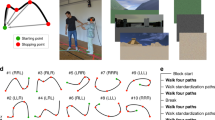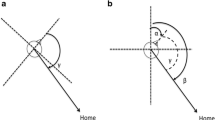Abstract
Efficient daily navigation is underpinned by path integration, the mechanism by which we use self-movement information to update our position in space. This process is well understood in adulthood, but there has been relatively little study of path integration in childhood, leading to an underrepresentation in accounts of navigational development. Previous research has shown that calculation of distance and heading both tend to be less accurate in children as they are in adults, although there have been no studies of the combined calculation of distance and heading that typifies naturalistic path integration. In the present study, 5-year-olds and 7-year-olds took part in a triangle-completion task, where they were required to return to the start point of a multi-element path using only idiothetic information. Performance was compared to a sample of adult participants, who were found to be more accurate than children on measures of landing error, heading error, and distance error. Seven-year-olds were significantly more accurate than 5-year-olds on measures of landing error and heading error, although the difference between groups was much smaller for distance error. All measures were reliably correlated with age, demonstrating a clear development of path integration abilities within the age range tested. Taken together, these data make a strong case for the inclusion of path integration within developmental models of spatial navigational processing.


Similar content being viewed by others
References
Acredolo LP, Evans D (1980) Developmental changes in the effects of landmarks on infant spatial behavior. Dev Psychol 16:312–318
Allen GL, Kirasic KC (1985) Effects of the cognitive organization of route knowledge on judgments of macrospatial distance. Mem Cognit 13:218–227
Alyan S, McNaughton BL (1999) Hippocampectomized rats are capable of homing by path integration. Behav Neurosci 113:19–31
Berthoz A, Amorim MA, Glasauer S, Grasso R, Takei Y, Viaud-Delmon I (1999) Dissociation between distance and direction during locomotor navigation. In: Golledge RG (ed) Wayfinding: cognitive mapping and spatial behavior. Johns Hopkins Press, Baltimore
Blades M, Medlicott LD (1992) Developmental differences in the ability to give route directions from a map. J Environ Psychol 12:175–185
Bredin J, Kerlirzin Y, Israel I (2005) Path integration: is there a difference between athletes and non-athletes? Exp Brain Res 167:670–674
Bremner JG, Hatton F, Foster KA, Mason U (2011) The contribution of visual and vestibular information to spatial orientation by 6-to 14-month-old infants and adults. Dev Sci 14:1033–1045
Campos JJ, Anderson DI, Barbu-Roth MA, Hubbard EM, Hertenstein MJ, Witherington D (2000) Travel broadens the mind. Infancy 1:149–219
Corlett JP, Patla AE, Williams JG (1985) Locomotor estimation of distance after visual scanning by children and adults. Perception 14:257–263
Cornell EH, Heth CD (2000) Route learning and wayfinding. In: Kitchin R, Freundschuh S (eds) Cognitive maps: past, present, and future. Routledge, London
Elliott D (1987) The influence of walking speed and prior practice on locomotor distance estimation. J Motor Behav 19:476–485
Frank AU (1991) Qualitative spatial reasoning with cardinal directions. In: 7 Österreichische artificial-intelligence-Tagung/Seventh Austrian conference on artificial intelligence. Springer, Berlin, pp 157–167
Fujita N, Klatzky RL, Loomis JM, Golledge RG (1993) The encoding error model of pathway completion without vision. Geograph Anal 25:295–314
Gallistel CR (1990) The Organization of Learning. MIT Press, Cambridge, MA
Giovannini L, Jacomuzzi AC, Bruno N, Semenza C, Surian L (2009) Distance perception in autism and typical development. Perception 38:429–441
Golledge RG (1999) Human wayfinding and cognitive maps. In: Golledge RG (ed) Wayfinding behavior. The Johns Hopkins University Press, USA
Golledge RG, Smith TR, Pellegrino JW, Doherty S, Marshall SP (1985) A conceptual model and empirical analysis of children’s acquisition of spatial knowledge. J Environ Psychol 5:125–152
Hermer L, Spelke ES (1994) A geometric process for spatial reorientation in young children. Nature 370:57–59
Hund AM, Plumert JM (2003) Does information about what things are influence children’s memory for where things are? Dev Psychol 39:939–948
Klatzky RL, Loomis JM, Golledge RG, Cicinelli JG, Doherty S, Pellegrino JW (1990) Acquisition of route and survey knowledge in the absence of vision. J Mot Behav 22:19–43
Kovas I, Kozma P, Fehér A, Benedek G (1999) Late maturation of visual spatial integration in humans. Proc Natl Acad Sci 96:12204–12209
Learmonth AE, Newcombe NS, Huttenlocher J (2001) Toddlers’ use of metric information and landmarks to reorient. J Exp Child Psychol 80:225–244
Loomis JM, Klatzky RL, Golledge RG, Cicinelli JG, Pellegrino JW, Fry PA (1993) Nonvisual navigation by blind and sighted: assessment of path integration ability. J Exp Psychol Gen 1:73–91
Loomis JM, Klatzky RL, Golledge RG, Philbeck JW (1999) Human navigation by path integration. In: Golledge RG (ed) Wayfinding: cognitive mapping and spatial behaviour. Johns Hopkins Press, Baltimore
Mittelstaedt ML, Mittelstaedt H (1980) Homing by path integration in a mammal. Naturwissenschaften 67:566–567
Mittelstaedt H, Mittelstaedt ML (1982) Homing by path integration. In: Papi F, Wallraff HG (eds) Avian navigation. Springer, Berlin
Mittelstaedt ML, Mittelstaedt H (2001) Idiothetic navigation in humans: estimation of path length. Exp Brain Res 139:318–332
Müller M, Wehner R (2010) Path integration provides a scaffold for landmark learning in desert ants. Curr Biol 20:1368–1371
Nardini M, Jones P, Bedford R, Braddick O (2008) Development of cue integration in human navigation. Curr Biol 18:689–693
Pellicano E, Smith AD, Cristino F, Hood BM, Briscoe J, Gilchrist ID (2011) Children with autism are neither systematic nor optimal foragers. Proc Natl Acad Sci 108:421–426
Philbeck JW, Loomis JM, Beall AC (1997) Visually perceived location is an invariant in the control of action. Percept Psychophys 59:601–612
Pickering SJ (2001) The development of visuo-spatial working memory. Memory 9:423–432
Plester B, Richards J, Blades M, Spencer C (2002) Young children’s ability to use aerial photographs as maps. J Environ Psychol 22:29–47
Plumert JM, Spencer JP (2007) The emerging spatial mind. Oxford University Press, New York
Presson CC (1987) The development of landmarks in spatial memory: the role of differential experience. J Exp Child Psychol 44:317–334
Rider EA, Rieser JJ (1988) Pointing at objects in other rooms: young children’s sensitivity to perspective after walking with and without vision. Child Dev 59:480–494
Rieser JJ, Pick HL Jr (2007) Using locomotion to update spatial orientation: what changes with learning and development? In: Plumert JM, Spencer JP (eds) The emerging spatial mind. Oxford University Press, New York
Rieser JJ, Rider EA (1991) Young children’s spatial orientation with respect to multiple targets when walking without vision. Dev Psychol 27:97–107
Ruddle RA, Lessels S (2006) For efficient navigational search, humans require full physical movement, but not a rich visual scene. Psychol Sci 17:460–465
Saint Paul UV (1982) Do geese use path integration for walking home? In: Papi F, Wallraff HG (eds) Avian Navigation. Springer, Berlin
Shemyakin FN (1962) General problems of orientation in space and space representations. In: Ananyey BG (ed) Psychological science in the USSR, vol 1. Office of Technical Services, Washington
Siegel AW, White SH (1975) The development of spatial representations of large-scale environments. Adv Child Dev Behav 10:9–55
Smith AD, Gilchrist ID, Hood BM (2005) Children’s search behaviour in large-scale space: developmental components of exploration. Perception 34:1221–1229
Smith AD, Howard CJ, Alcock N, Cater K (2010) Going the distance: spatial scale of athletic experience affects the accuracy of path integration. Exp Brain Res 206:93–98
Wan X, Wang RF, Crowell JA (2013) Effects of basic path properties on human path integration. Spat Cogn Comput 13:79–101
Wehner R, Srinivasan MV (1981) Searching behaviour of desert ants, genus Cataglyphis (Formicidae, Hymenoptera). J Comp Physiol 142:315–338
Wiener JM, Mallot HA (2006) Path complexity does not impair visual path integration. Spat Cogn Comput 6:333–346
Wiener JM, Berthoz A, Wolbers T (2011) Dissociable cognitive mechanisms underlying human path integration. Exp Brain Res 208:61–71
Worsley CL, Recce M, Spires HJ, Marely J, Polkey CE, Morris RG (2001) Path integration following temporal lobectomy in humans. Neuropsychologia 39:452–464
Acknowledgments
The authors wish to thank the children and carers who took part in the experiment and are particularly grateful to Dr Lucy Cragg and the rest of the Summer Scientist Week organising committee.
Author information
Authors and Affiliations
Corresponding author
Rights and permissions
About this article
Cite this article
Smith, A.D., McKeith, L. & Howard, C.J. The development of path integration: Combining estimations of distance and heading. Exp Brain Res 231, 445–455 (2013). https://doi.org/10.1007/s00221-013-3709-8
Received:
Accepted:
Published:
Issue Date:
DOI: https://doi.org/10.1007/s00221-013-3709-8




